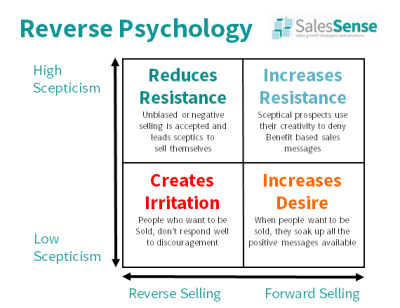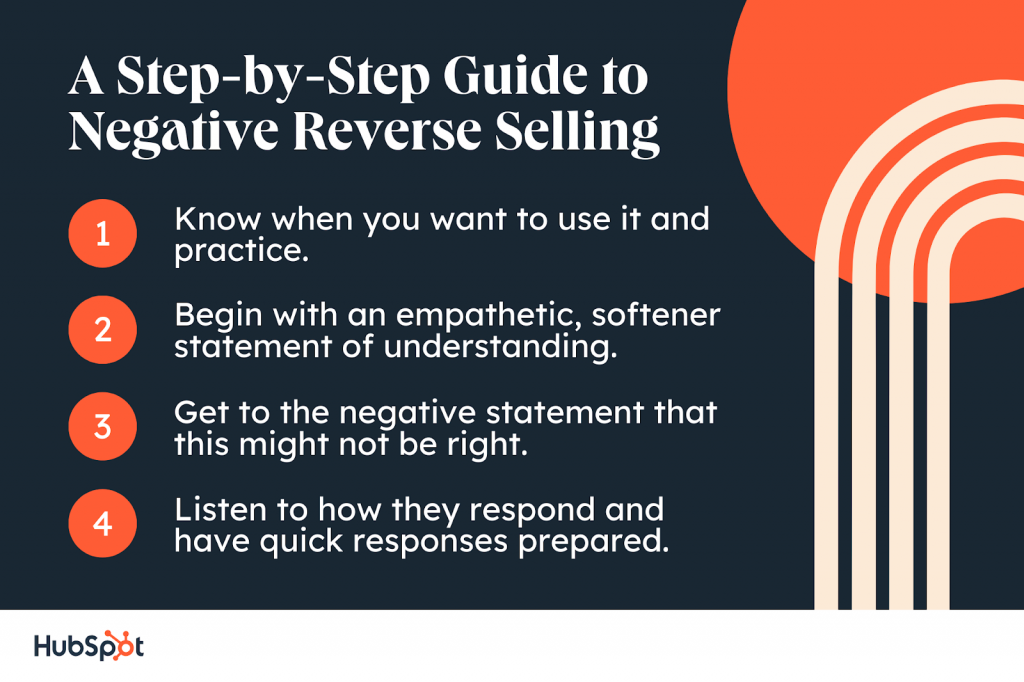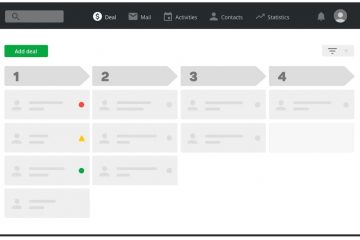Negative Reverse Selling: Here’s How You Close Stalling Deals
Updated on May 1, 2024

Image Source: salessense.co.uk
In the world of sales, a simple “no,” can seem like a definite end of the conversation.
But it doesn’t have to end at that point because good sales people has a few tricks up their sleeves that can take advantage of a negative and turn that into a positive.
Now, it’s impossible to convert every lead into a customer. But, some strategies do exist that can turn an ambiguous prospect into a raving customer.
How?
Through negative reverse selling.
What Is Negative Reverse Selling?
Negative reverse selling uses reverse psychology to test a prospect’s resolve and overcome stalemate situations with counter-intuitive sales approaches.
Reverse psychology is a tactic that involves promoting a behavior opposite to the desired outcome. The goal is to encourage the other party to choose the behavior that is actually desired by suggesting the contrary.
In typical sales interactions, salespeople face various worries, objections, and concerns from potential clients. To secure a sale, these hurdles must be addressed and overcome. Negative reverse selling can be particularly useful in situations where direct methods stall, allowing salespeople to tactically overcome objections by seemingly aligning with them, thus prompting the prospect to reconsider their stance and potentially decide in favor of the sale.
Origins of Negative Reverse Selling
In 1967, David H. Sandler developed negative reverse selling as part of the Sandler Selling System. The system’s objective is to have reps be guides rather than being salesmen who are just trying to close deals. It needs sales reps to focus on active conversations and align with a buyer’s resolve.
You don’t need to utilize the negative reverse selling method for all deals; it is only necessary when the situation is challenging to overcome.
Some people use negative reverse selling to gauge the reaction of their customers rather than rushing to close a transaction at the first opportunity.
As Sandler puts it, this is like fishing.
Imagine that you’re out on the water, casting a line. After some time, you feel a bite. You don’t immediately set the hook, but you let the fish run some of the line.
Fisherman, be patient at this crucial time. It’s best to let the fish take the bait so they can catch themselves. The negative reverse sales method is all about guiding the conversation in the direction that your customers want to go. All that’s left is to pull the line tight and release the fish.

Why Is Negative Reverse Selling so Effective?
You’ll never be able to convince a prospect to buy from you if they themselves don’t want to. They’ll fight back. The common hurdle is that there is a desire to buy, yet there is a reluctance to be marketed to.
In a typical situation, salespeople will reply to objections or concerns from customers in a compelling way. But the prospects are prepared to push back if the sales representative tries to persuade them too aggressively.
The only way you can get them to do what you want is to tug them in the opposite way. Their natural inclination to ‘draw away’ from sales representatives will lead them in the direction you desire.
The customer must be led to believe that the solution is in the product that you’re selling. Your potential buyer will then believe that it was their idea all along if you correctly implement negative reverse selling techniques.
They develop their own rationales for why the product or service you’re offering is a good idea, why they’re prepared, and why they have what they need.
It’s all about going backward in order to move forward with the prospect!

Image Source: Hubspot
The Benefits of Negative Reverse Selling
Negative reverse selling is beneficial for a variety of reasons. Take into account the following:
It helps to expedite the sales process: “I’ll get back to you,” or “I’ll hold a meeting with my staff and let you know” are some of the responses you’ve received repeatedly from a prospect. Negative reverse selling helps you to either close the deal or remove them from the prospect list. It saves you both time and energy in the long run.
It improves your position: Reverse selling places you in a position of strength and confidence, encouraging buyers to take a deeper look at your product or service.
It convinces customers that they require your goods or service: The scarcity theory is put into effect via negative reverse selling. A sense of loss is triggered when you take the offer off the table or hint at doing so, making the prospect believe that they genuinely need or desire what you’re offering.
It allows you to go on to the next prospect interested in what you have to offer: It’s possible that your product or service isn’t a good fit for the customer.
It can help you get out of a bind: As a last resort, you can say something like “Maybe now isn’t the right time” or “Perhaps we’re not a good fit” to someone who is reluctant to say “no.”
These statements make it easy for the prospect to decline the offer, allowing you to move on to the next opportunity. The customer may even tell you why they are not interested in your product. That’s valuable information for the sales team.
How to Implement Negative Reverse Selling Properly
Negative reverse selling isn’t for everyone, and it doesn’t work in every sales situation. It shouldn’t be used as a primary means of sales, but rather as a backup strategy, only when absolutely essential.
We will discuss some of the best strategies for negative reverse selling.
Recognize when negative reverse selling is appropriate.
Among these are:
- Prospects who repeatedly postpone or cancel appointments for demos or phone conversations.
- When they don’t respond quickly enough.
- When clients say they need to think about it or discuss it with another stakeholder.
- When people challenge your pricing, value, method, delivery, and other things.
- When a potential customer says “maybe” as an answer.
- Prospects who don’t want to talk to you.
You are unable to acquire an unequivocal “yes” or “no” from your customers in any of these situations. If you give them the push in the other way, it may save you time and lead them to your products or services.
If you’ve had a few cancellations or missed appointments in the past, don’t let it affect your outlook on the future. The most important thing here is to look for recurring patterns.
If someone cancels a demo once, there’s a good chance they have a solid reason. Depending on the situation, the customer may also need to consult with their supervisor, partner, or someone else before agreeing to a deal.
Negative reverse selling might be used if the customer keeps making excuses or always seems to be unavailable.
Know Your Audience
Use the strategy on the right individuals at the right time, based on your knowledge of your prospects. They may easily “agree” to your negative comment without putting up a struggle. Agreeable and passive folks are not the ideal fit for this sales strategy.
A-type players who enjoy making decisions or competitive people who need to prove themselves are the perfect targets for your negative reverse selling.
Negative reversal sales power phrases that work
There are several different ways in which negative reverse selling works.
Some situations necessitate asking probing questions to get new information while other situations may hint at you triggering FOMO (fear of missing out) in a prospect.
Make a statement that makes it appear as though you’re encouraging the opposite of what you want them to accomplish.
- “Not everyone will be satisfied with our offering.”
- “This product is not for you if…”
- “Don’t buy anything if you’re not sure if it’s right for you.”
- “If I understand you correctly, this service isn’t high on your list of priorities at the moment.”
- “If you don’t appear interested in the offer, we should probably just drop it.”
- “I’m not interested in wasting your time, so this will be the final email I write you.”
- “Does this fit within your budget?”
- “We think our product or service might be out of your price range.”
- “Since I haven’t heard from you in a while, I’m going to presume you’ve lost interest in the offer.”
- “I think we should re-evaluate if this product/service is the right fit for your needs.”
There are no hard and fast rules on when to use these remarks, as each situation and customer is unique.
Adding soothing phrases or inquiries before negative remarks is also a smart habit. Before “our answer may not be the best fit,” you may say, or for example, “You’re right,” or “I get it.”
Regardless of what you decide to say to the potential customer, always be courteous. You don’t want to come across as arrogant, even if you project confidence and authority.
Importance of Patience and Listening
Patience and listening are critical in negative reverse selling. This approach requires understanding the prospect’s real issues and timing your responses carefully. By listening more and speaking less, you can better gauge the true objections and motivations, leading to more effective use of this technique.
Use Softening Statements
Before delivering a potentially negative or challenging statement, using softening phrases can help maintain a positive interaction. Phrases like “It sounds like,” “I see,” or “You might have a point,” set a more collaborative tone and prevent the prospect from feeling attacked or overly pressured.
Don’t Go Overboard
You don’t have to undersell your products to do negative reverse selling. Even if you’re implying that your product doesn’t work for your consumers, you should avoid openly pointing out their inadequacies or giving them reasons not to buy.
Knowing when to halt negative reverse selling is essential. Don’t push the consumer away as soon as they start responding to your requests more frequently. Help reel them in without being too eager.

Image Source: Hubspot
5 Use Cases and Examples of Negative Reverse Selling
Last Resort in a Deal Breaker Situation
This strategy is utilized when negotiations hit a stalemate due to a prospect’s firm demands that are unfeasible or beyond the scope of what your company can offer. This could be about pricing, product customization, or contract terms that simply aren’t viable. Negative reverse selling is applied to make the prospect reconsider the importance of these demands or to reveal their true deal breakers.
Example: Imagine a prospect insisting that they need an unrealistic delivery timeframe which your company cannot meet. You might respond with, “It seems like we won’t be able to meet your required delivery date. Perhaps it’s best if you consider a supplier with more immediate availability?” This might prompt the prospect to reconsider the urgency and negotiate a more reasonable timeframe if they value your product’s quality or the relationship.
Slow Sales Cycle with Your Prospect Procrastinating
When a prospect drags their feet on making a decision, often asking for more information, more meetings, or more time, without moving closer to a purchase. This tactic aims to prompt the prospect to either commit to moving forward or to admit they are not ready to buy, thereby preventing the sales cycle from being indefinitely prolonged.
Example: If a prospect continuously asks for more information or delays the decision, you could say, “It looks like you’re not ready to proceed at this moment. Should we touch base next quarter?” This might lead them to realize the urgency of making a decision now or clarify the real reasons behind their hesitation.
High Expectations or Resistance from Your Prospect
This occurs when a prospect has either unrealistic expectations from your product or service or when they resist certain aspects of your offering. The use of negative reverse selling here helps to realign expectations by subtly challenging these demands or by making the prospect defend their expectations, often leading them to a more realistic viewpoint.
Example: Suppose a prospect expects premium service on a basic plan. You might say, “If you are looking for these high-level features, our basic plan might not meet your needs.” This could lead them to either adjust their expectations or consider a more appropriate (and possibly more expensive) tier.
Lack of Frequent Engagement and Prospect Going Cold
When a prospect who initially showed interest suddenly becomes less responsive, it may indicate a loss of interest or a shift in priorities. By using negative reverse selling, you can bring this issue to the forefront, forcing the prospect to confront their interest level directly, which helps clarify whether to continue investing in this lead.
Example: If a previously responsive prospect starts to go silent, you might say, “I haven’t heard back from you, so I assume this project isn’t a priority for you right now.” This statement could prompt them to re-engage actively or confirm that they no longer are interested, saving you time.
Dealing with Price Objections
Frequently encountered in sales, price objections occur when a prospect feels the cost of the service or product is too high. Negative reverse selling here serves to challenge the prospect’s valuation of the product indirectly, encouraging them to justify the price themselves or to openly discuss the budget constraints they are facing.
Example: If a prospect objects to the cost, you could respond with, “It sounds like you’re not ready to invest in this solution at its current price. Perhaps we should explore less costly alternatives?” This may make the prospect reconsider the value of your offering or confirm that price is the genuine sticking point.
Each of these scenarios leverages the core principle of negative reverse selling to nudge the prospect towards revealing their true stance, enabling more effective navigation of the sales process.
Sell more, understand your customers’ journey for free!
Sales and Marketing teams spend millions of dollars to bring visitors to your website. But do you track your customer’s journey? Do you know who buys and why?
Around 8% of your website traffic will sign up on your lead forms. What happens to the other 92% of your traffic? Can you identify your visiting accounts? Can you engage and retarget your qualified visitors even if they are not identified?



